Explore which high-growth U.S. jobs are being nearshored to Latin America and how your business can benefit.
The Job Market Is Booming, But For Whom?
America’s job market is on fire in 2025, despite layoffs across private and goverment jobs. New roles are emerging, AI is transforming every industry, and the need for skilled professionals has never been higher. Every client we have asks for us to add an interview question about, how is the candidate leveraging AI in their work.
When choosing a career path or hiring strategy, it’s crucial to consider which field offers the highest growth rate. Understanding industry trends helps in making informed decisions about which fields are expanding rapidly and where opportunities are most promising.
But here’s the uncomfortable truth: unless you’re in the top 20% of U.S. workers, your job is likely to be replaced, either by artificial intelligence or by someone using AI more efficiently (and affordably) from Colombia, Brazil, or Argentina. This comes as, workers’ confidence in their ability to find or hold a job dropped by 8 points year-over-year in December (from +50 to +42, on a scale from -100 to +100). That’s the lowest level it’s reached since the survey began in the spring of 2020 in the early days of the global pandemic, when workers’ average job confidence score was +43.
According to LinkedIn’s Jobs on the Rise 2025, nearly half of the 25 fastest-growing jobs in the U.S. can now be done remotely. The high growth rate of these fields makes choosing where to focus hiring or career development even more important. That means they can be nearshored, and often are. At LatamCent, we see U.S. SaaS companies increasingly hiring top 10% talent from Latin America for roles like cybersecurity, marketing, data science, and financial analysis.
If you own a software business, or are an executive in the SaaS space, the message is clear: don’t just follow the trend, capitalize on it.
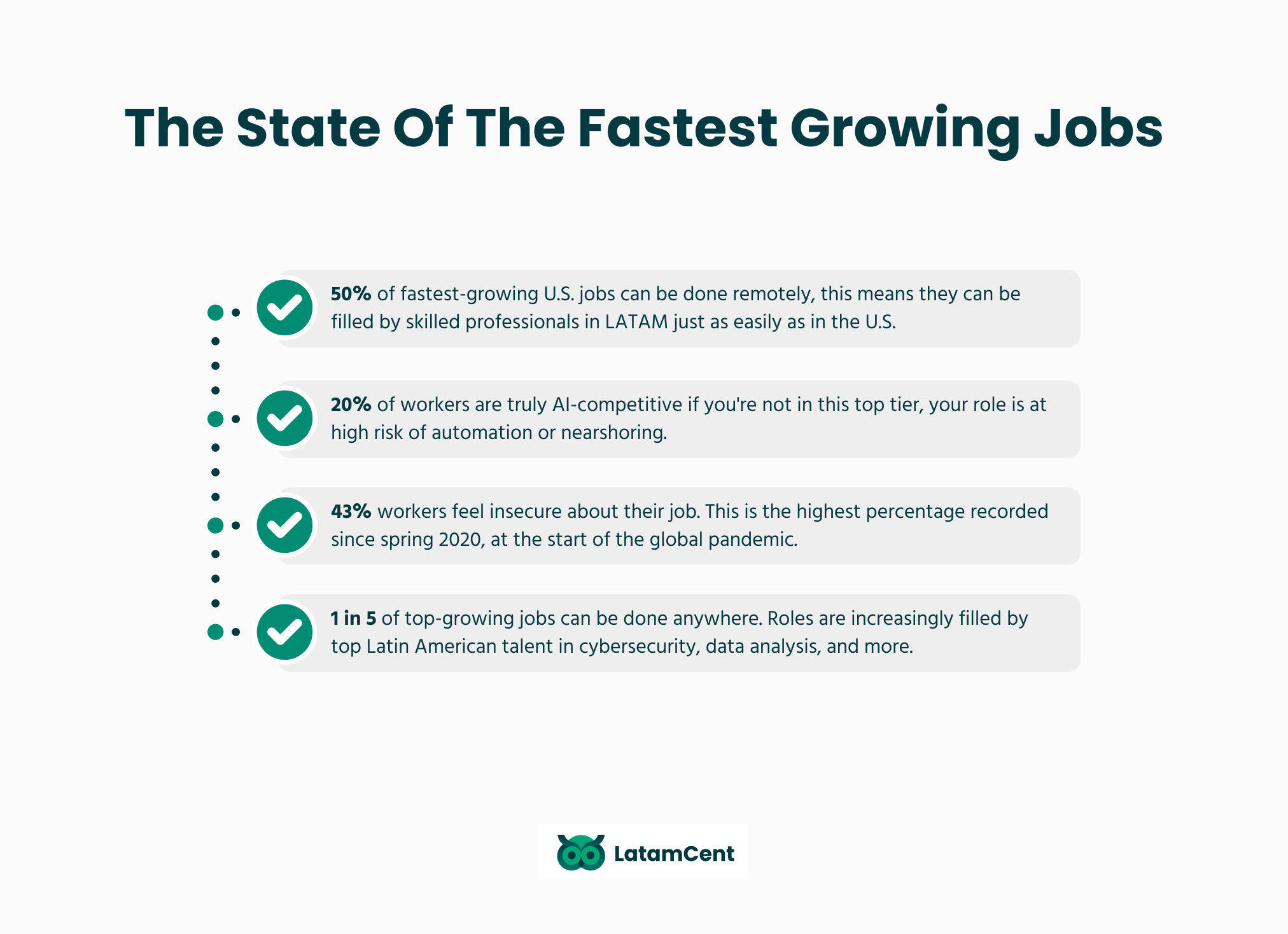
Introduction to Emerging Careers
The U.S. job market is undergoing a dramatic transformation, driven by rapid advancements in technology, automation, and evolving industry needs. According to the Bureau of Labor Statistics (BLS), many of today’s most in-demand roles such as artificial intelligence specialists, research analysts, and physical therapists barely existed a decade ago. As industries adapt to new technologies and data-driven processes, the fastest growing careers are those that offer both high pay and long-term job security. For example, research analysts and physical therapists are projected to see growth rates exceeding 20% over the next ten years, making them some of the most attractive options for those looking to pursue a future-proof career. To stay competitive in this evolving landscape, it’s essential to develop in-demand skills, keep pace with emerging trends, and focus on fields like artificial intelligence, cybersecurity, and analytics, which are expected to grow rapidly and remain at the forefront of the job market.
Driving Forces Behind Growth
Several powerful forces are fueling the rise of new careers and job openings across the U.S. economy. Automation and artificial intelligence are reshaping entire industries, creating a surge in demand for professionals who can design, implement, and manage these technologies. The Bureau of Labor Statistics (BLS) projects that employment in technology-related occupations will grow by 13% from 2020 to 2030 much faster than the average for all occupations. This growth is also being driven by the increasing need for data-driven decision-making, as businesses across industries seek skilled analysts to interpret complex data and guide strategy. As a result, roles in data analytics, software development, and cybersecurity are among the most in-demand, with opportunities expanding as companies embrace remote work and virtual collaboration. The rise of these fields means that professionals who can analyze data, manage automation, and support digital transformation are well-positioned to thrive in the evolving job market.
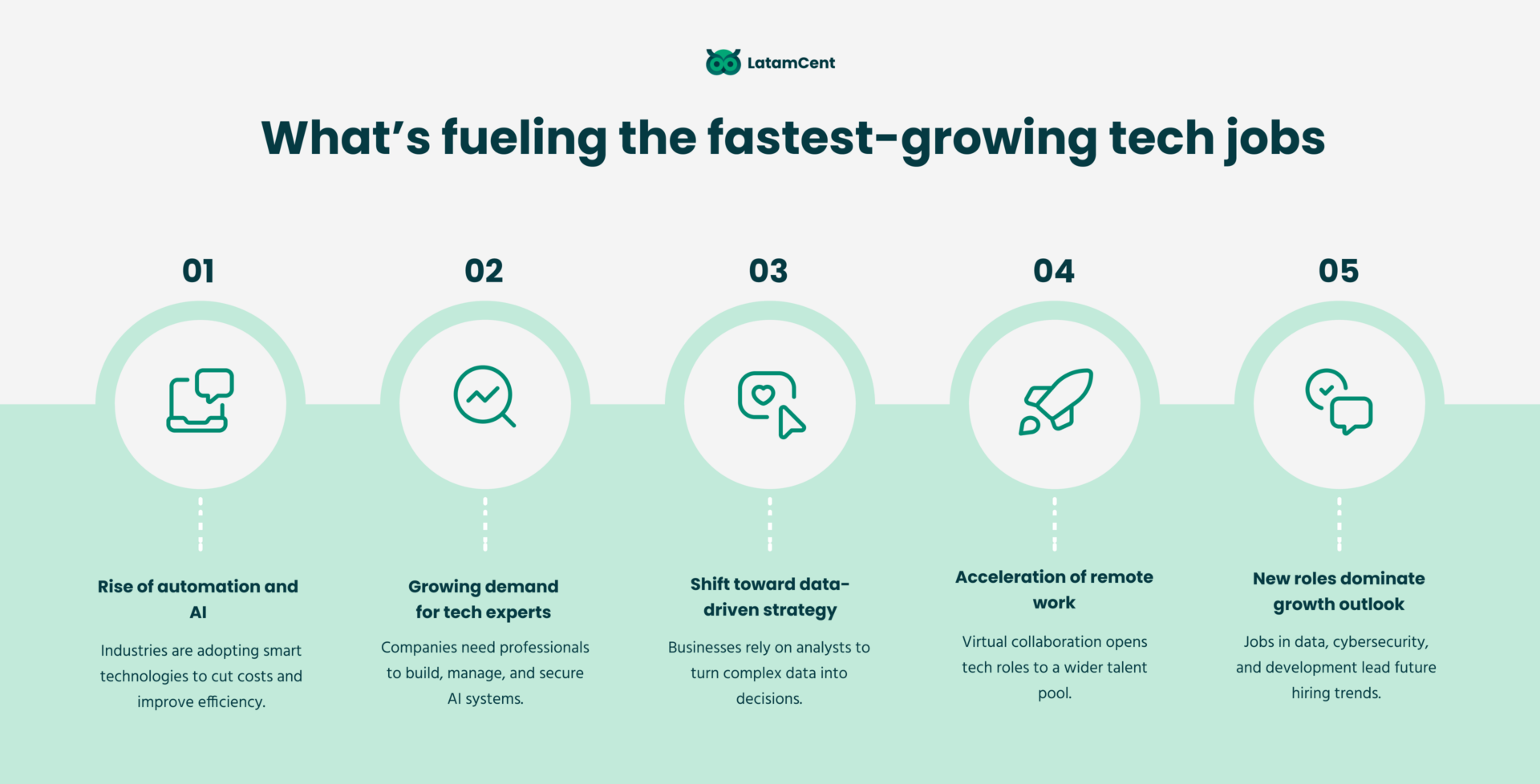
Top 11 High-Demand Careers That Can Be Nearshored in 2025
Here are the top 11 fastest growing careers, ranked by demand and highest pay, that Venture and Private Equity-backed software companies are hiring for nearshore in Latin America, capitalizing on rising job openings and labor statistics rather than competing with saturated talent pools in Silicon Valley, New York, Austin, or Miami.
1. AI & Machine Learning Engineers
From Brazil to Argentina, engineers are helping U.S. startups accelerate their digital transformation by contributing to software development, data infrastructure, and automation projects. Skills in Python, cloud architecture, and frameworks like TensorFlow are widely available across the region, reflecting the strength of specialized AI and machine learning programs that prepare engineers for these roles, as well as the growing demand for tech professionals in the Latin American job market.
In the U.S., the top 50% of software engineers working in automation and infrastructure roles earn around $150,000 per year. In Latin America, similarly skilled professionals earn closer to $60,000 annually, while the very best those who can compete with Silicon Valley talent can be hired for about $120,000, creating a compelling case for businesses focused on cost savings and rapid growth. These engineers often work on developing and optimizing AI-powered applications for businesses, ensuring that software applications meet evolving user needs.
Brazil, Argentina, and Mexico continue to lead the region in producing high-caliber AI engineers with advanced degrees and practical industry experience, especially in areas like cloud systems, analytics, and backend architecture. These countries are now central to the global tech employment landscape, offering scalable solutions for U.S.-based companies seeking reliable talent.
Top skills include Python, TensorFlow, PyTorch, cloud architecture (AWS, GCP), deep learning, and NLP. In addition to standard languages and toolset, our staffing and recruiting clients are asking us for candidates that understand and know “Vibe Coding”. One VP of Engineering told us it’s a must, and whomever they hire needs to level up their team in AI usage.
2. Artificial Intelligence Consultants & Researchers
Besides software engineers, Latin America is producing AI consultants and researchers experts who shape product strategy, define ethical automation, and help companies keep pace with rapidly changing circumstances. Research analysts are in great demand. They collect, organize, and interpret complex data, and report their findings and insights to stakeholders or decision-makers. This helps various industries make smarter decisions. One such industry is software. Others are finance and healthcare.
In the U.S., employment in these roles offers an average salary around $140,000 per year, reflecting both their specialization and growing relevance in today’s job market. In Latin America, top professionals in the same career path earn between $40,000 and $55,000 annually, giving employers the ability to build strategic teams while keeping costs competitive and aligned with regional growth rates.
Argentina and Colombia have strong research institutions and tech hubs producing exceptional AI talent, global partnerships, and robust R&D ecosystems. Their universities and tech hubs are actively producing top-tier AI and research talent, making them critical contributors to the future of the industry and the broader employment landscape.
3. Growth Marketing Managers
Growth marketers are essential for helping B2B SaaS companies scale revenue and reach new customers. They focus on building smart marketing strategies, testing campaigns, improving funnels, and balancing costs with long-term customer value. In the U.S., top-performing growth marketers earn between $110,000 and $130,000 per year. In Latin America, experienced professionals earn around $30,000 to $48,000, making it an attractive option for companies looking to grow without overspending.
Colombia, Argentina, and Mexico produce sharp growth marketers with strong experience in paid media, email automation, and marketing analytics. Many have worked with international companies and understand how to adapt campaigns for different audiences and markets.
Some of the most valuable skills today include funnel planning, A/B testing, ad management across Google, Meta, and LinkedIn, and measuring performance through attribution models. As more businesses look to expand in competitive industries, the demand for these marketing professionals continues to rise and the right talent can make all the difference in turning strategy into sustainable growth.
4. Sales Development Representatives (SDRs)
SDRs are the engine behind pipeline growth, and more SaaS companies are shifting outbound roles to Latin America for one reason: it works. The top reps aren’t just dialing and emailing they’re qualifying deals, moving leads through the funnel, and driving real revenue.
U.S.-based SDRs in the top 50% earn $75K–$90K OTE. In LATAM, that same level of performance costs $24K–$40K. The talent’s there, and the economics make sense. Colombia, Mexico, and Peru are producing SDRs who are fluent, persistent, and know how to operate across tools like LinkedIn, Apollo, and HubSpot without needing hand-holding.
Core skills? Cold calling. Writing outbound that gets responses. Keeping the CRM clean. Knowing how to handle brush-offs and push through. These aren’t junior reps learning on the job they’re professionals who’ve been trained, tested, and are hungry to close.
We’ve been building SDR teams in the region for over a decade. Across the board, they beat U.S. averages in meetings booked, consistency, and tenure. When you find reps who want to win and stick around long enough to matter, that’s where the real value is and LATAM delivers.
5. Digital Marketing Specialists
Paid media buyers, SEO analysts, and content specialists are running high-performance campaigns that generate real pipeline, not vanity metrics. And the cost difference is hard to ignore: top 50% U.S. digital marketers earn $95K–$110K/year. In LATAM, you’ll get top-tier talent for $24K–$42K.
Colombia, Mexico, and Argentina have become serious marketing hubs. There’s a deep bench of bilingual professionals with experience across SEO, PPC, creative strategy, and analytics platforms like GA4 and HubSpot. They’re performance-driven operators who understand how to turn data into decisions.
This is one of the best first roles to nearshore. For the price you hire an US agency for you can typically hire 2-4 specialists in SEO, PPC, Content, and Video.
6. Content Strategists & Copywriters
Brands need voice, and Latin America delivers. Content strategists and copywriters create engaging and effective content for brands. We’re seeing SaaS companies tap into bilingual content marketers to scale thought leadership, demand gen, and even podcast production from afar. U.S. salaries hover around $90K. In LATAM, top talent earns $20K–$38K. You get professionals who know how to write for B2B, not just fill space.
Key skills: long-form writing, SEO planning, brand voice, and storytelling that lands. Good copy is hard to fake build a solid review process and use tools like Surfer SEO to keep quality high.
Copywriting is a tougher one to get right since there is so much AI content, make sure you have good processes in place to check for AI written content and leverage tools like Surfer SEO to optimize your content before publishing.
7. Software Engineers (Front-End, Back-End, Full-Stack)
Software engineering drives product innovation and Latin America has become a reliable source of full-stack developers. With thousands of engineers trained in modern stacks like React, Node.js, and AWS, the region is now central to global hiring strategies in the tech industry.
Top 50% of U.S.-based software engineers earn $115K–$130K/year. In LATAM, you’ll find highly capable professionals at $35K–$60K. Brazil, Argentina, and Peru lead the region for depth, scalability, and experience.
Key skills include JavaScript, TypeScript, Node.js, REST APIs, test-driven development, and CI/CD pipelines. This role remains one of the fastest growing careers we staff at LatamCent alongside with Front-End Engineers from Latam.
8. Customer Success Managers
CSMs with U.S. time zone overlap and C1/C2 English? That’s LATAM’s bread and butter. More companies are hiring CSMs in Colombia to manage mid-market and SMB clients with high satisfaction. U.S.-based CSMs earn $85K–$110K/year. In LATAM, top talent earns $24K–$40K. That delta lets companies scale without cutting quality. Colombia, Mexico, and Chile have strong CX and SaaS experience pools.
These roles are in demand across industries, especially as businesses look to grow rapidly while protecting retention.
Top skills: onboarding, account management, upselling, QBR prep, and issue tracking ensuring support files are handled quickly and customers stay happy.
9. Business Analysts & Financial Analysts
Excel wizards, BI pros, and FP&A analysts in LATAM analyze financial and business data to help CEOs make better decisions daily. We’ve staffed entire finance teams with analysts from Argentina and Brazil all remote, all effective.
We’ve helped employers build full finance teams in Argentina and Brazil. U.S. salaries average $90K–$110K; top LATAM analysts earn $28K–$45K. Strong training programs and finance-focused universities make Argentina and Brazil standouts in the region.
Top skills include financial modeling, Excel, SQL, Power BI/Tableau, forecasting, and business case analysis.
10. Outside Sales Representatives
Sales is no longer bound by borders. In Latin America, B2B sales reps are closing deals, running demos, and building pipelines across the globe. They’re embedded in U.S. go-to-market teams working alongside SDRs, marketers, and CSMs from day one.
U.S. reps earn $90K–$120K OTE. In LATAM, you’ll find top-performing talent at $30K–$50K. Colombia and Mexico lead the region with a deep bench of SaaS sales pros trained in remote sales, fluent in English, and wired for persistence.
Top skills include full-cycle selling, CRM fluency (HubSpot/Salesforce), discovery, product demoing, and negotiation.
11. Revenue Operations Managers
Revenue operations managers keep marketing, sales, and CS aligned by syncing tools, fixing broken processes, and turning raw data into growth levers.
More companies are nearshoring RevOps roles to Latin America, where you’ll find sharp operators with SaaS experience and deep CRM knowledge. U.S. RevOps managers earn $120K–$140K/year; in LATAM, it’s $36K–$55K. Argentina, Brazil, and Chile are home to top-tier talent.
Top skills include HubSpot/Salesforce administration, dashboarding, forecasting, GTM process mapping, and automation setup.
Nearshoring and Outsourcing: A Strategic Perspective
For businesses aiming to stay agile and competitive, nearshoring and outsourcing have become essential strategies. By relocating certain operations such as administrative assistance, customer service, and IT support to nearby countries with skilled workforces, companies can reduce costs while maintaining high standards of quality and efficiency. This shift is fueling demand for professionals with strong project management, communication, and cross-cultural skills. As supply chains go global and software drives more workflows, people who understand how to collaborate across borders will lead in industries where employment and growth rates continue to rise.
If you’re looking to pursue a career in a fast-moving, high-demand landscape, this is where it’s happening.
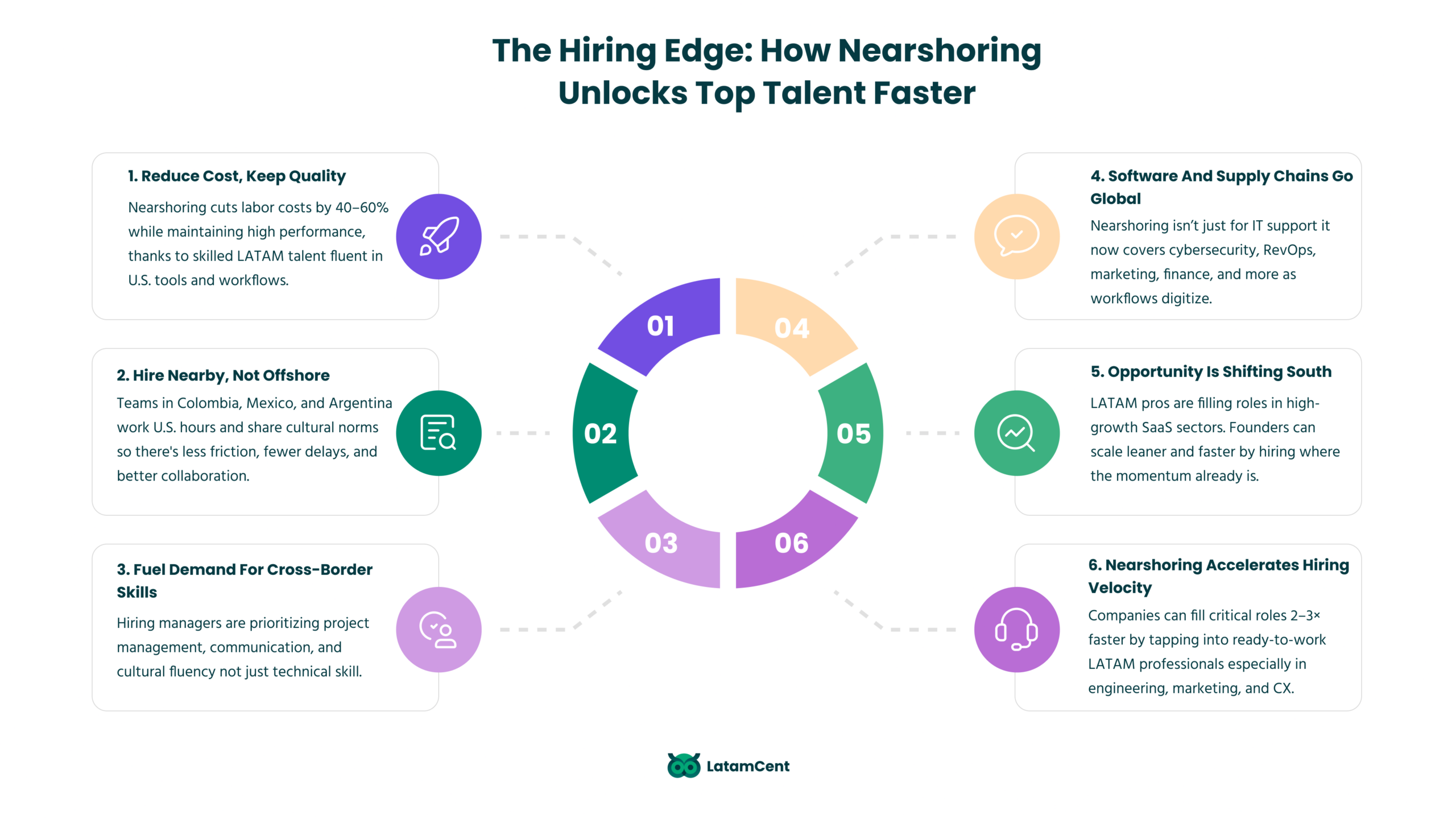
In-Demand Skills and Roles
The fastest growing careers are those that require a blend of technical expertise and adaptability. According to the BLS, skills in data analysis, programming, and digital marketing are among the most sought-after by employers. Careers in artificial intelligence, software development, and cybersecurity are expected to see job openings increase by more than 30% over the next decade, reflecting the growing reliance on technology across all sectors. Additionally, roles such as auditors, accountants, and financial analysts remain in high demand as companies navigate complex regulatory environments and seek to ensure financial stability. To stay ahead, individuals should focus on building skills in cloud computing, machine learning, and data visualization, and consider pursuing careers in engineering, healthcare, and technology fields that are projected to experience significant growth and offer strong long-term prospects.
Career Development and Future-Proofing
In a job market defined by rapid change, career development and future-proofing are more important than ever. To remain competitive, professionals must commit to ongoing education and training, especially in areas like technology, data analysis, and digital marketing. Employers increasingly value candidates who can adapt to new trends, collaborate across teams, and solve complex problems. According to the BLS, workers who invest in continuous learning are more likely to advance in their careers and achieve higher earnings. By prioritizing skill development, staying informed about industry trends, and embracing new technologies, individuals can position themselves for success in the future job market ensuring their careers remain resilient and in demand, no matter how the world of work evolves.
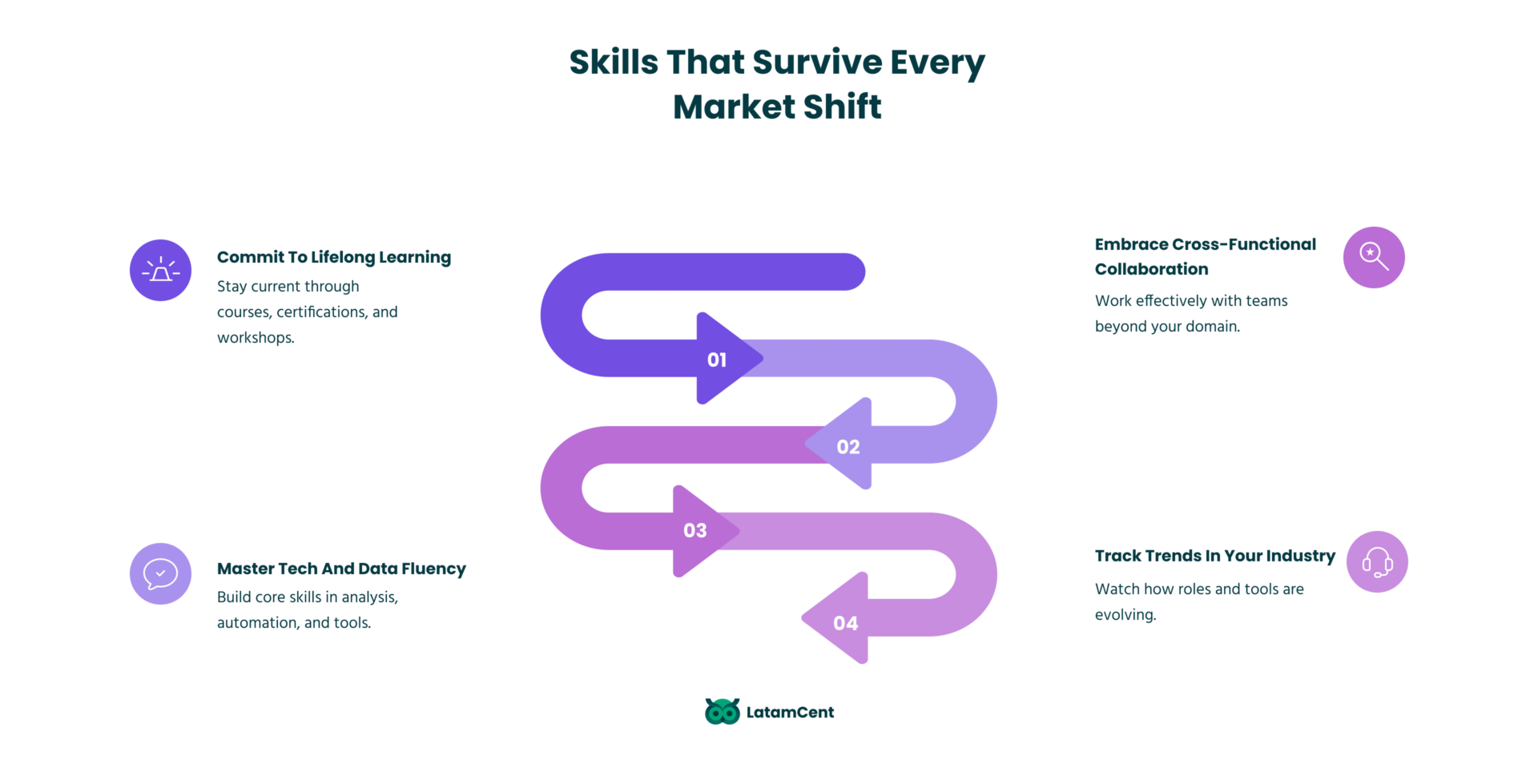
2026 and beyond is about nearshoring as a strategy beyond cost savings
The job market is growing fast, but where work happens has permanently shifted. Artificial intelligence is reshaping industries and flattening global competition. If a job only needs a laptop and Wi-Fi, there’s already someone in Latin America doing it well.
The real advantage? It’s not labor arbitrage. It’s access to world-class talent. Smart companies aren’t nearshoring to cut costs they’re doing it to hire the best AI engineers, RevOps managers, and growth strategists who can actually move the needle. These aren’t back-office hires they’re core team members who drive outcomes, own growth, and raise the bar.
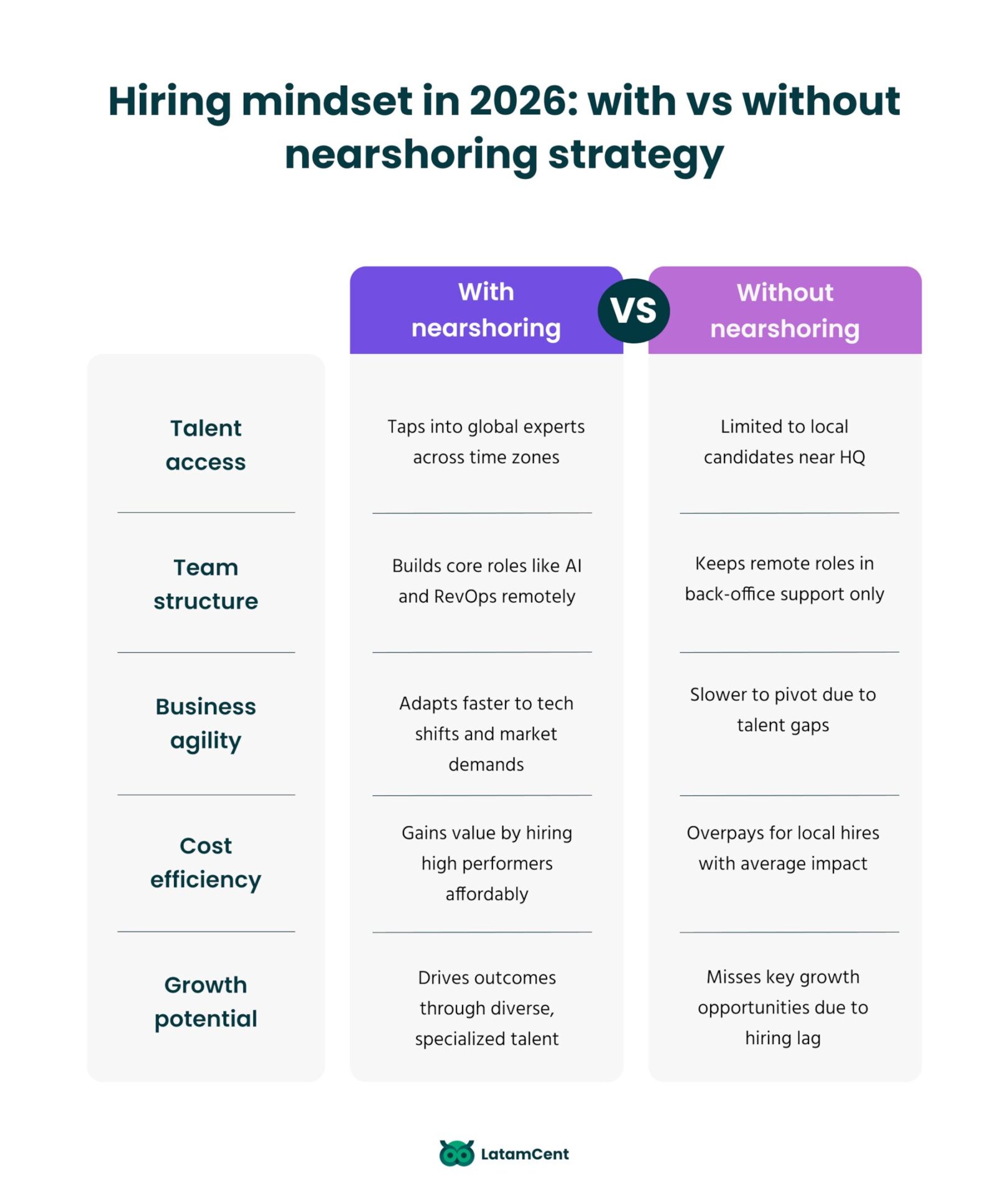
The winners will be the ones who hire across borders now. The rest? Still stuck thinking top talent lives within 30 miles of their HQ.
If you haven’t hired someone from Latam yet, what are you waiting for?



